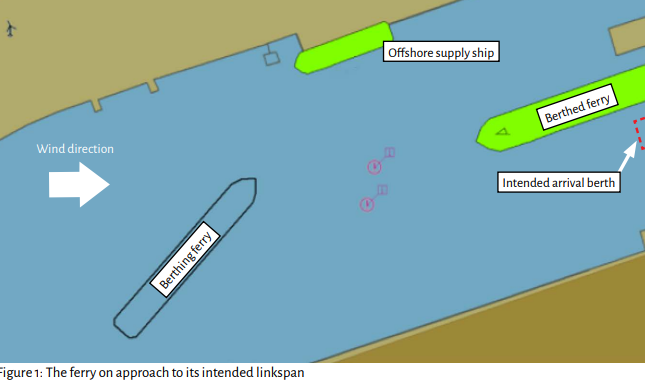As UK MAIB reports in its most recent Safety Digest, a ro-ro ferry was attempting to berth in a small northern European port at night in high winds. The three operational linkspans at the ferry port required vessels to moor stern to and another ferry occupied the middle linkspan.
The incident
As the ferry entered the harbour the wind was blowing from the west at about 35kts, which met the company’s upper wind limit for permissible berthing. The ferry had to perform a 180° turn within the harbour to enable it to back onto its intended linkspan.
The wind increased to around 60kts as the ferry began to turn, pushing it very close to an offshore supply ship berthed on the northern breakwater inside the harbour. The crew of the ferry used the bow thruster and main engines to hold the vessel up into the wind, but the force was too strong for the vessel to hold position while positioned fully beam on to it. The ferry was blown eastward toward the ferry already berthed in the middle linkspan and the two vessels collided, the moving ferry hitting the bow of the stationary ferry with its starboard shoulder.
The damage to both vessels was assessed and the incoming ferry departed the harbour and anchored until the wind abated; it berthed later that evening without further incident.

Lessons learned
- Margin of safety → This case highlights the delicate balance between maintaining schedules and ensuring the safety of vessel operations. While it may be necessary to make timely decisions to enter a harbour or berth in challenging weather conditions, it is crucial to carefully assess the risks and take appropriate precautions. It is important for masters and operators to closely monitor weather forecasts, adhere to established company limits for vessel operations and exercise prudent judgment when making decisions that could affect the safety of the vessel and its crew and passengers.
- Communicate → Effective communication between the master, crew and shore personnel is essential: crew members should be vigilant and ready to respond to changing weather conditions; the master should be prepared to alter plans or delay entry into a harbour to ensure the safety of the vessel and its occupants.
- Action → It would have been foolhardy to attempt to berth the vessel in the increasingly strong winds and the master of the incoming ferry made the right decision to go to anchor following the collision. This allowed both crews to undertake a full assessment of the damage to their vessels and provided essential thinking time to appraise the situation and take appropriate action to berth safely in harbour when the winds subsided.




























































